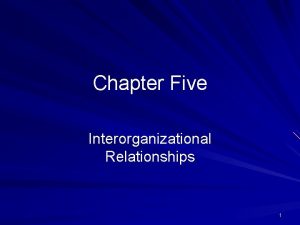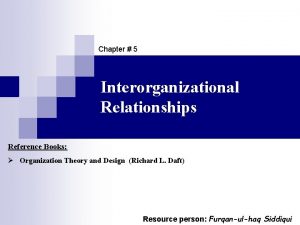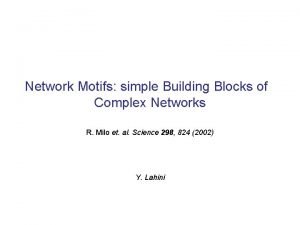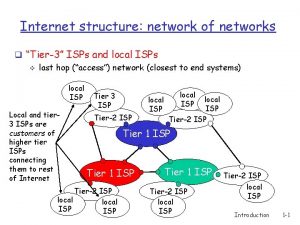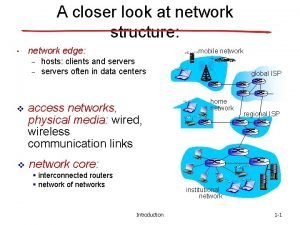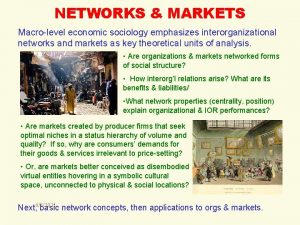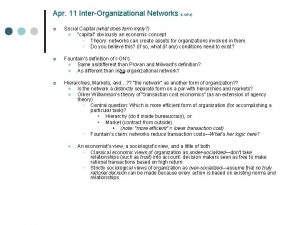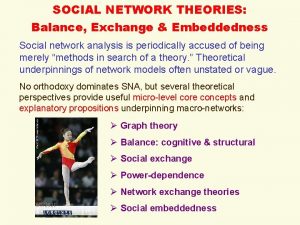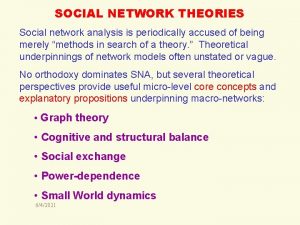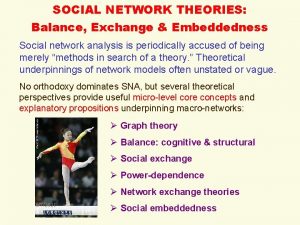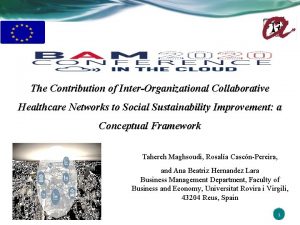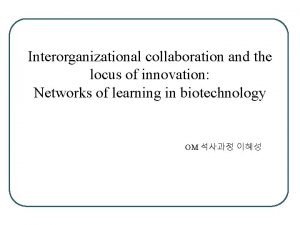INTRA INTERORGANIZATIONAL NETWORKS Social network theories of intra












- Slides: 12

INTRA- & INTERORGANIZATIONAL NETWORKS Social network theories of intra- & interorg’l behavior examine the structural forms and relational contents that connect actors in complex networks spanning multiple levels of analysis • Structural form – positions and patterns in networks of relations between actors in a system Vertical-hierarchical vs. horizontal structures Central vs. peripheral positions/roles Popular stars, hangers-on, isolates • Relational content – quality of relations: type of ties (toft) Resource exchanges: financial transactions Communication: information & advice Collaboration: joint project participation 9/25/2020

Sociometric Origins Although roots of network analysis lie in the 1920 s (Freeman 1996), Jacob L. Moreno (1934) pioneered social network application to “psychodrama” therapy. He used sociomatrices and hand-drawn sociograms to display children’s likes and dislikes of classmates in the form of directed graphs (digraphs). Dyadic relations of ego & alter are primary units of analysis. Graph theory and matrix algebra are the foundational methods to represent multiple networks of relational contents connecting Q actors in q x q matrices. Computer programs such as UCINET identify actor prominence and jointly occupied positions. Cluster & plotting programs MDS, Krackplot, Pajek, Visone create visual displays of the social distances between actors. 9/25/2020

Anthropology & Sociology In 1950 s, social anthropologists at Manchester University extended sociometric techniques to studies of families, kinship, friendship networks in urban settings of both advanced and developing societies. John Barnes applied analytic rigor to concept of “social network. ” He saw “the whole of social life” as “a set of points some of which are joined by lines” to form a “total network” of relations. The informal sphere of interpersonal relations was a “partial network” within this total network (Barnes 1954: 43). In 1970 s, sociologists at Harvard, Chicago, Toronto & elsewhere applied finite mathematical, graph theoretic, clustering, and spatial modeling methods to uncover small group structures and community networks ► Conflict among novice monks in a monastery (White et al 1976) ► Cleavages in urban political networks (Laumann & Pappi 1976) ► Community lost, preserved, or extended? (Wellman 1979) By 1990 s, network analysis had proliferated to organization studies, business management, public administration, law, and related fields ► Strategic alliance networks (Gulati 1995) 9/25/2020 ► Self-managed work teams (Barker 1999)

Varieties of Network Centrality By interacting, employees come to occupy central positions in intraorg’l communication and exchange networks. A more central location reflects ego’s demand from others (high prestige as a target of popular choices ) and greater reach (access to information, economic & political resources) • Degree: high volume of direct contacts regardless of “quality” • Closeness: rapid access to & influence over others • Betweenness: mediation of others’ ties (brokerage, s-holes) Bureaucratic hierarchies are asymmetric authority networks (legitimate power) based on command-obey & report-to relations of superiors and subordinates. Betweenness centrality useful to a Machiavellian “player” who can bridge unconnected others. Workteams are egalitarian networks based on advice & trust relationships to build coworker solidarity and boost collective 9/25/2020 performance. As in dancing and horseshoes, closeness counts.

Workplace Networks Centralities in multiplex workplace networks – the authority, advice, assistance, communication, conflict, enmity, friendship, trust etc. relations – may explain such individual, group, and org’l outcomes as job satisfaction, performance, productivity & profit David Krackhardt (1999) conducted a clique analysis of the advice and friendship networks among employees of Silicon Systems, a small high-tech startup company. A subsequent union drive flip-flopped from pro to anti. Krackhardt located change-of-heart in friendship crosspressures on Chris. Unable to satisfy the norms of two opposing cliques, Chris abandoned the union organizing campaign to supporters who had fewer persuasive ties. Next slide displays a blockmodel-MDS reanalysis of the social distances in both networks, consistent with Krackhardt’s story about the structural cleavages among pro-union employees (Knoke 2001) 9/25/2020

9/25/2020 Fig 6. 6. Social Distances in Advice and Friendship Networks of Silicon Systems (based on Krackhardt 1999) SOURCE: Knoke Changing Organizations (2001: 227)

Forming Interorg’l Relations At the org’l level of analysis, theories examine interorganizational relations (IOR). Emergent properties arise when nonunitary collective actors interact, exchange, bargain, compete, collaborate, conflict, . . . Network theories try to explain origins and consequences of IOR ties • Requires new theoretical concepts (e. g. , governance forms)? • Are IORs simply the aggregation of individuals’ relations? • Do organizations have motives & emotions, interests & goals? EX: Can orgs trust one another, or only people? • How do persons occupying role of organizational agent behave differently than when acting as self-interest individuals? • What cross-level person-organization relations are important? EX: Org’s ties to employees, shareholders, customers/clients 9/25/2020

Strategic Alliances Between org’l hierarchies & market relations fall several short-lived, hybrid IOR forms, where two or more orgs jointly occupy positions Strategic alliance: at least two partner firms that (1) remain legally independent; (2) share benefits, managerial control over performance of assigned tasks; (3) make contributions in strategic areas, e. g. , technology or products (Yoshino & Rangan 1995) Hierarchical Relations SA governance forms vary in the types of legal & social mechanisms to coordinate & safeguard alliance partners’ resource contributions, administrative responsibilities, divide rewards from their collaboration (Todeva and Knoke 2003) 9/25/2020 ----------------------------JOINT VENTURES COOPERATIVES EQUITY INVESTMENTS R&D CONSORTIA STRATEGIC COOP. AGREEMENTS CARTELS FRANCHISING LICENSING SUBCONTRACTOR NETWORKS INDUSTRY STANDARDS GROUPS ACTION SETS ----------------------------Market Relations

Where do IOR Come From? Interorg’l relations originate in combinations of environmental constraints and endogenous network structures that generate new social-economic relations intended to acquire control of resources & maximize org’l performances (profit, R&D innovation, sales, regulatory autonomy) Gulati & Gargiulo dynamic model with endogenous feedback loop from present network structure (past alliances, common 3 rd parties, joint centralities) to transform future alliances: 9/25/2020 Relational Embeddedness Structural Embeddedness Positional Embeddedness Structural Differentiation Strategic Interdependence NETWORK FORMATION

An Org’l-Field Theory IOR analyses also focus on explaining macro-structures at the complete network level, disregarding individual persons or orgs. Kenis & Knoke (2002) combined organizational field with network properties to develop a field-net explanation of aggregate change • Communication ties (info exchanges) are the primary IOR, a necessary prerequisite to future interfirm collaborations • Changes in the communication network’s formal properties (density, centralization) alter opportunities for firms to find available partners • Rates of change vary nonlinearly, initially accelerating with changes in communication network structures, then slowing with saturation or ceiling effects • But, given its heavy longitudinal data demands, how testable is this so 9/25/2020 -called “theory”?

Networks Change Alliances Changes in the formal properties of an organizational field’s communication network generate nonlinear rates of change in interorganizational tie-formation rates (e. g. , strategic alliances): DENSITY RECIPROCITY TIE CONFIRMATION CONNECTIVTY CENTRALIZATION MULTIPLEXITY SUBGROUP COHESION HIERARCHY 9/25/2020 RATE OF STRATEGIC ALLIANCE FORMATION

References Barker, James R. 1999. The Discipline of Teamwork: Participation and Concertive Control. Thousand Oaks, CA: Sage Publications. Barnes, John. 1954. “Class and Committees in a Norwegian Island Parish. ” Human Relations 7: 39 -58. Bott, Elizabeth. 1957. Family and Social Network: Roles, Norms, and External Relationships in Ordinary Urban Families. London: Tavistock. Freeman, Linton C. 1996. “Some Antecedents of Social Network Analysis. ” Connections 19: 39 -42. Gulati, Ranjay. 1995. “Social Structure and Alliance Formation Patterns: A Longitudinal Analysis. ” Administrative Science Quarterly 40: 619 -652. Krackhardt, David. 1999. “Ties That Torture: Simmelian Tie Analysis in. Organizations. ” Research in the Sociology of Organizations 16: 183 -210. Laumann, Edward O. and Franz Urban Pappi. 1976. Networks of Collective Action: A Perspective on Community Influence Systems. New York: Academic Press. Mitchell, J. Clyde. 1969. Social Networks in Urban Situations: Analyses of Personal Relationships in Central African Towns. Manchester: Manchester University Press. Moreno, J. L. 1934. Who Shall Survive? Washington: Nervous & Mental Disease Publishing Co. White, Harrison C. , Scott A. Boorman and Ronald L. Breiger. 1976. “Social Structure from Multiple Networks, I: Blockmodels of Roles and Positions. ” American Journal of Sociology 81: 730 -780. Wellman, Barry. 1979. “The Community Question: The Intimate Networks of East Yorkers. ” American 9/25/2020 Journal of Sociology 84: 1201 -1231.
 Jenis klasifikasi sistem informasi
Jenis klasifikasi sistem informasi Interorganizational relationship
Interorganizational relationship Conflict resolution meaning
Conflict resolution meaning Conflict resolution unit
Conflict resolution unit Interorganizational relationships framework
Interorganizational relationships framework Virtual and datagram networks
Virtual and datagram networks Basestore iptv
Basestore iptv Pearson vue pcnse
Pearson vue pcnse Principles of network applications
Principles of network applications Network motifs: simple building blocks of complex networks
Network motifs: simple building blocks of complex networks Network layer design issues in computer networks
Network layer design issues in computer networks Tier 3 isps
Tier 3 isps Internet structure network of networks
Internet structure network of networks

